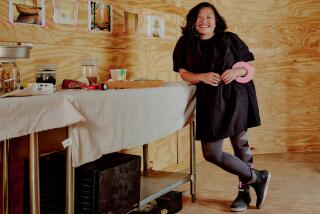Vietnam Photo Exhibit Steps Into the Breach
- Share via
As the 25th anniversary of the fall of Saigon draws near (April 30), a photo exhibit titled “Touch” at Cypress College depicts life within and outside Vietnam in an attempt to bring together viewers fascinated by its culture.
“Many of the pictures stress a love of the homeland and an interest in people of Vietnamese heritage regardless of where they live,” said curator Jerry Burchfield, a photography instructor at the college.
“There are still a lot of wounds and problems, families that are split. We wanted the show to create a bridge between people, despite their differences.”
Though all the artists were born in Vietnam, some left and settled in the United States and Europe. Several try to separate their homeland from the war, focusing instead on images depicting contemporary Vietnamese life.
As one photographer, Thin Le, writes in the exhibit catalog: “Living in the U.S. and always seeing Vietnam treated as a war spurred me to go back and start a photographic project that showed a glimpse of Vietnam unrelated to war, from the perspective of the native son.”
For other Vietnamese American artists, their native land is more than a geographical place--it’s a remembrance of things past.
“I miss Saigon so much,” writes 31-year-old Ryan Pham, who studies photography at Cal State Fullerton. In 1999, Pham went back to Saigon, and he chose (like Proust) to record everyday subjects such as a street vendor selling tomatoes and onions from a woven basket.
Viewers will notice differences between the older and younger generations of these artists. The older generation, still living in Vietnam, typically focuses on landscapes and ceremonies. The younger generation is not as loyal to the traditional subjects; many of their photos are documentary in style, and many try--through composition and technique--to mark the art with their signatures.
Tran Manh Dat’s almost abstract red-colored print of a woman with a dan ty ba, a ukulele-like instrument, shows a distinctly conceptual--though emotional-- approach.
Dat writes in the catalog: “I use the camera as a painter uses a brush to paint, or a writer a pen to write. I seek to expose my thoughts and my emotions to others.”
Nhung Cong Tran’s silver gelatin prints of everyday subjects are almost as abstract. “Port for the Pedicabs” is a tightly composed black-and-white picture of rickshaw drivers dozing in their cabs as they wait for customers.
Other artists address the dilemma of living between two cultures.
Hanh Thi Pham’s photographs show the changing role of femininity in the United States and Vietnam. One photo is an ironic portrait of herself, dressed in a traditional white Vietnamese dress, looking unflinchingly at the camera while holding a pipe.
But co-curator Brian Doan said the exhibit is not about cultural and political differences, it’s about Vietnamese heritage.
“We wanted to do something positive, to make a different point about Vietnam,” he said. “Not many Americans know Vietnam as a place of culture.”
Doan suggested the show to Burchfield two years, and they began contacting photographers in the United States and Vietnam.
Doan visited family in Vietnam and made contact with artists there. After viewing a multitude of portfolios, he and Burchfield selected 22 artists--nine from Vietnam, 12 from the United States, and one from Germany.
Gathering their pictures in Cypress took almost two years; they had to get permission from the Vietnamese Ministry of Culture to exhibit the works of these artists.
Meanwhile, in the United States, the Bowers Museum of Cultural Art’s “A Winding River,” a Vietnamese-themed exhibit, caused controversy in the local Vietnamese American community when it opened in June 1999.
“We really worried that the community would misunderstand the exhibit,” Doan said.
But so far no controversy has emerged. Doan said the show’s purpose--bringing together Vietnamese, Vietnamese Americans and anyone interested in their culture--has been achieved.
“We wanted to put people in touch [with each other]. Even though people live in different continents, they still touch through the images of Vietnam.”
BE THERE
“Touch”: continues through April 6 at Cypress College, 9200 Valley View St. Because of its size and scope, the exhibition is displayed at three campus locations: the Fine Arts Gallery, the Library Gallery and the Photography Gallery. The Fine Arts Gallery is open Monday through Thursday 10 a.m. to 2 p.m., Tuesday and Wednesday evenings 6 to 8 p.m. The other galleries are open Monday through Thursday 9 a.m. to 9 p.m., Friday and Saturday 9 a.m. to 1 p.m. Call (714) 484-7443 or (714) 484-7133.
More to Read
The biggest entertainment stories
Get our big stories about Hollywood, film, television, music, arts, culture and more right in your inbox as soon as they publish.
You may occasionally receive promotional content from the Los Angeles Times.










